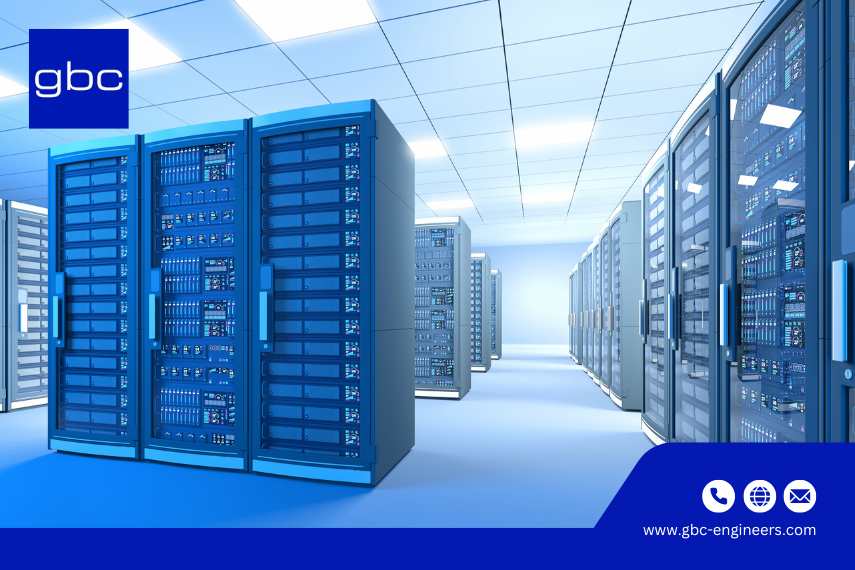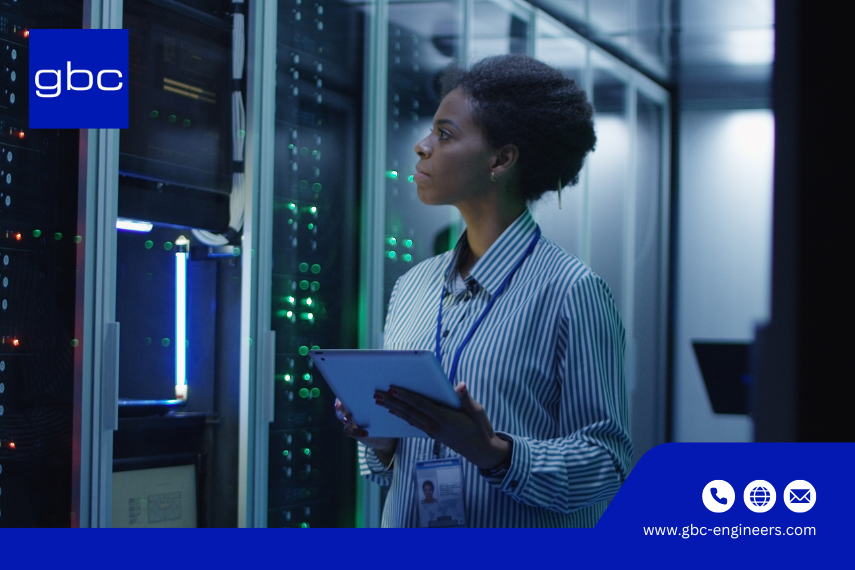Center Facility is a specialized, secure environment designed to house computing, networking, and storage systems essential for modern digital operations. These facilities are integral to the infrastructure that supports cloud computing, artificial intelligence (AI), and the broader digital economy.
What is a data center facility and how does it work? Let’s explore the core of digital transformation with insights from gbc engineers.
Core Components of a Data Center Facility
An effective data center design must balance performance, efficiency, and reliability—especially as businesses increasingly rely on the seamless availability of enterprise data, various types of data, and critical applications.
With the rise of cloud native applications, big data analytics, and hybrid IT environments, modern data centers must also address new demands on scalability and flexibility. This requires advanced data center management practices and coordination across multiple platforms, including colocation facilities that provide scalable infrastructure to support dynamic enterprise needs.
At the heart of this infrastructure lie two foundational systems: Power Infrastructure and Cooling & Environmental Control. These ensure data center uptime, data storage integrity, and advanced data center security.
1. Power Infrastructure
a. Uninterruptible Power Supply (UPS)
UPS solutions are critical to maintaining continuous operation in the event of power interruptions. These solutions provide short-term power to IT equipment during the gap between an outage and the activation of backup generators. There are typically two types:
- Static UPS: Uses batteries and inverters.
- Rotary UPS: Uses kinetic energy stored in flywheels.
Uninterruptible power supplies are crucial components of both private and public data centers, ensuring essential services remain active without interruption.
b. Backup Generators
Usually diesel-powered, generators are designed to provide power for extended outages. They're triggered automatically once the UPS systems are activated. Data centers often have multiple generator units configured for redundancy (N+1 or 2N).
c. Power Distribution Units (PDUs)
PDUs distribute electricity safely and efficiently from UPS systems to server racks. Intelligent PDUs allow remote monitoring and control, enabling real-time power consumption analysis.
Overall, data centers rely on a well-orchestrated combination of power supplies, cooling mechanisms, and management platforms to maintain operational excellence across cloud native, on-premise, and colocation environments.
2. Cooling and Environmental Control Systems
Maintaining optimal temperature and humidity levels is essential to prevent hardware failure.
a. HVAC (Heating, Ventilation, and Air Conditioning)
HVAC systems maintain the ambient climate within the data center. They are designed with redundancy (N+1 or greater) to avoid overheating in case one unit fails.
b. Computer Room Air Conditioning (CRAC) / Air Handling Units (AHUs)
These are specialized units designed to cool server rooms. They may use raised floors or overhead ducts to distribute cool air effectively.
c. Hot/Cold Aisle Containment
To increase cooling efficiency, data centers use containment strategies that physically separate hot air expelled from servers from the cool air being drawn in.
d. Humidity Control
Controlling humidity prevents static discharge or condensation, both of which can damage equipment. Humidifiers and dehumidifiers are integrated into HVAC systems for this purpose.
3. Fire Detection and Suppression Systems
a. Fire Detection
Early smoke detection is vital in a data center facility. Devices like Very Early Smoke Detection Apparatus (VESDA) continuously sample the air for trace amounts of smoke. This allows for rapid identification of fire risks, even before a fire is visible, giving staff the time to respond quickly and mitigate the threat.
Early detection technologies are essential to protecting types of data, particularly cloud data, which is often stored across multiple locations in a distributed system.
b. Fire Suppression
Traditional water-based fire suppression technologies are unsuitable for data center infrastructure because they can cause significant damage to data storage systems. Instead, most data centers opt for gas-based suppression solutions, such as FM200 or inert gases, that displace oxygen in the affected area to suppress the fire without risking damage to the servers, storage devices, or other critical equipment.
This is particularly important for businesses that rely on public cloud and hybrid cloud infrastructures, where uptime and data integrity are crucial.
4. Network Infrastructure
The core of data center functionality relies on fast, reliable data transmission.
a. Cabling
Structured cabling infrastructures (fiber optics and copper) connect servers, switches, and storage solutions. Cable management is crucial for airflow and serviceability.
b. Switches and Routers
These devices manage data flow both within the data center and to external networks. They are usually configured in redundant clusters to ensure high availability.
c. Redundant Connectivity
Multiple internet service providers (ISPs) and redundant network paths ensure failover capabilities in the event of a network failure.
5. Physical and Cyber Security
a. Physical Security
- Access Control: Biometric scanners, smart cards, and mantraps control access.
- Surveillance: 24/7 CCTV systems monitor all entry points and critical zones.
- Security Personnel: On-site security teams provide another layer of protection.
b. Cybersecurity
Firewalls and IDS/IPS: These systems monitor and filter network traffic for malicious activity.
VPNs and Network Segmentation: Used to create secure communication channels and isolate sensitive areas of the network.

6. Monitoring and Management Systems
a. Building Management Systems (BMS)
These systems monitor facility-related functions such as power, HVAC, and lighting. They offer a dashboard view of all environmental and mechanical systems.
b. Data Center Infrastructure Management (DCIM)
DCIM software provides a more IT-centric view, tracking server performance, rack density, and resource utilization in real-time.
c. Remote Management Tools
Remote KVM (keyboard, video, mouse) solutions and IP-based tools allow technicians to manage servers and resolve issues without being physically present.
7. Redundancy and Fault Tolerance
High-availability data centers are designed with redundancy in every layer to ensure that operations continue seamlessly, even in the event of component failure, maintenance, or disaster scenarios. This is crucial in cloud data centers, where continuous uptime is paramount for businesses relying on cloud service providers and modern data center operations.
In physical facilities, redundancy is implemented across power, cooling, and network infrastructures to protect types of data from disruption.
Redundancy is classified as follows:
- N: Standard capacity
- N+1: One additional component for backup
- 2N: Two completely independent solutions
These measures allow data centers to maintain high levels of reliability and minimize the risk of downtime.
For businesses depending on cloud service and operating in environments like public cloud or hybrid cloud, this type of redundancy is critical to ensure that enterprise data and cloud data are always accessible.
Read More: What Is an Enterprise Data Center?
8. Compliance and Standards
Data centers must comply with industry regulations such as:
- ISO 27001: Information security management
- SOC 1/2/3: Service organization controls
- PCI DSS: For payment card data
- HIPAA: For healthcare data
- Uptime Institute Tiers: Defines availability levels from Tier I (basic) to Tier IV (fault-tolerant)
9. Modularity and Scalability
Modern data centers are increasingly adopting modular designs. These allow operators to scale capacity by adding prefabricated units, saving on construction time and cost.
Redundancy and Fault Tolerance
To ensure continuous operation, data centers implement redundancy strategies that are critical to maintaining the reliability and availability of data centers data, especially in colocation data centers where multiple tenants rely on uninterrupted service.
These strategies are essential for a physical facility and types of data centers, including cloud data centers and colocation data environments, where multiple businesses share infrastructure resources and rely on cloud services.
- Redundant Power and Cooling Systems: Multiple power feeds and cooling units prevent single points of failure.
- Data Replication: Critical data is replicated across multiple systems or locations to prevent loss during failures.
- Disaster Recovery Planning: Comprehensive plans are in place to recover operations swiftly in the event of a catastrophe.
Read More: 3 Types of Cloud Data Center Architecture

Importance in the Digital Economy
Data centers are foundational to the digital economy, enabling services such as:
- Cloud Computing: Providing the infrastructure for cloud service providers to host applications and data.
- Artificial Intelligence and Machine Learning: Supporting the computational needs of AI and ML workloads, a data center enables a business to leverage powerful computing resources for advanced analytics, predictive modeling, and automation. These technologies are becoming increasingly crucial for organizations seeking to gain insights and optimize their operations.
- E-commerce and Online Services: Ensuring the availability and performance of online platforms and services.
Global Expansion and Investment
The demand for data centers is driving significant investments worldwide:
- In Europe, companies are reconsidering their cloud service providers amid geopolitical tensions, leading to increased investment in regional data centers.
- In Africa, the World Bank's International Finance Corporation is investing $100 million in Raxio Group to boost digital infrastructure across the continent.
Ready to Future-Proof Your Data Center?
Partner with gbc engineers to design a facility that delivers performance, reliability, and long-term value.
🌐 Visit: www.gbc-engineers.com
🏗️ Explore Our Services: Services - gbc engineers
Conclusion
In summary, data center facilities are critical infrastructure components that support the digital services and applications integral to modern life. Their design emphasizes reliability, security, and scalability to meet the growing demands of the digital economy.
Whether you are looking to build new data centers, enhance existing ones, or integrate sustainable practices, GBC Engineers is committed to providing solutions that meet your business needs and safeguard your data.
Partner with us to create data center infrastructures that are resilient, scalable, and aligned with the future of digital business.